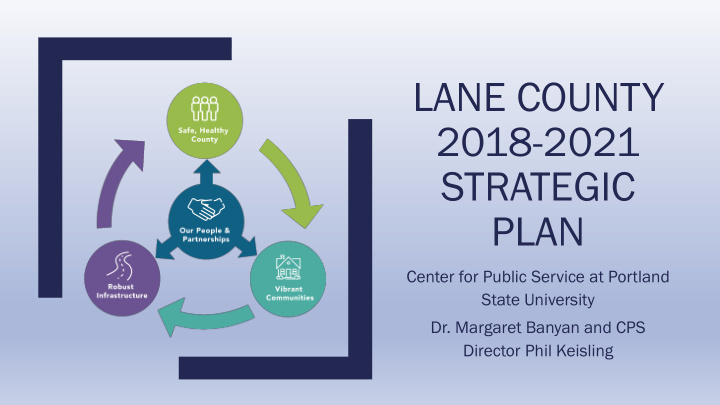



LANE COUNTY 2018-2021 STRATEGIC PLAN Center for Public Service at Portland State University Dr. Margaret Banyan and CPS Director Phil Keisling
Input & Involvement ■ Focus Groups: Employee and Community ■ Project Kick-Off with Lane County Leadership ■ Board Work Session ■ Employee Survey: 653 opened; 335 complete responses ■ Community Survey: 792 opened; 303 complete responses – Spanish language survey open until 3/1 ■ Open House(s): Employee and Community
Vision • Mission Previous Recommended Vision ion Vision ion Lane County is recognized as the best Lane County is recognized as the best county to live, work, and play county in which to live, work, and play Mission ion Mission ion We responsibly manage limited We responsibly manage available resources to deliver vital, customer- resources to deliver vital, community- focused services with passion, centered services with passion, drive, innovation, and integrity. and focus.
Purpose • Values • Behaviors Recommended Previous Values lues Purp rpos ose Integrity To improve lives Respect Open and Accountable Values lues Public Engagement Integrity Pursuit of Excellence Excellence Diversity Equity and Respect Stewardship Empathy Co Core Behavio iors Passion to serve Drive to connect Focused on solutions
Strategic Priorities
Key Strategic Initiatives a) Increase housing options for residents to reduce the incidence of homelessness and increase affordability b) Increase access to prevention and treatment services and develop programs and policy focused on behavioral health, community health, and youth c) Maintain and enhance public safety funding and service delivery, focusing on improvements to services in outlying and rural areas d) Pursue effective diversion, corrections, probation, and parole programs and practices to reduce detainment and incarceration in youth and adults
Key Strategic Initiatives a. Invest in a resilient, diverse, and sustainable regional economy b. Pursue programs and practices that reduce impacts on and leverage the natural environment to enhance livability and economic development c. Enhance equity and access in service delivery and representation in governance
Key Strategic Initiatives a. Enhance safe transportation facilities and operations b. Maintain existing facilities and identify efficiencies in capital assets c. Fund and develop new facilities that support safety and livability
Key Strategic Initiatives a. Pursue strategies to enhance fiscal resilience and operational effectiveness b. Enhance employee engagement and resilience c. Embrace internal and external partnerships to leverage and extend county goals
Implementation & Measurement ■ Create Alignment Target Metric ■ Simple Scorecard / snapshot Actionable ■ Recommendations Track outputs Accessible Program performance • Transparent & Credible & Simple Data Measure outcomes • Social and economic impact Common Interpretation • Organizational health Adapted from CDC
Draft Metrics – Under Development Safe, , Health thy y County ty Robust ust Infr frastructure astructure • Proportion of cost burdened low-income households • Crashes and fatalities by mode (household income less-than or equal to 30% • Age of capital assets Housing Urban Development Area Median Family • Deferred facility maintenance Income) • Percent of space utilization • Housing inventory of shelters (number of shelters by type of client served) • Number of Tier 2 and 3 Primary Care Patient Our Peopl ple and Pa Partner ershi ships ps Centered Medical Homes (PCPCH) (CHIP) • General fund reserves percent • Public safety response time • Financial liquidity • 1st time arrests • NES employee survey (2 questions) • Number of individuals completing diversions • Retention rate Vibran ant t Communi nities es • Percent of families with incomes below the living wage • Percent of population within close proximity to healthy food retail outlets Total employment in targeted industry sectors • • Environmental indicator(s) • Minority and business set aside(s) • Visitor data
Respond to Finalize feedback measures Incorporate Tentative Next Steps additional adoption March survey data 13, 2018 Finalize document and deliver
QUESTIONS FEEDBACK RECOMMENDATIONS
Recommend
More recommend